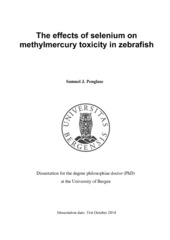| dc.contributor.author | Penglase, Samuel | eng |
| dc.date.accessioned | 2014-11-04T15:47:33Z | |
| dc.date.available | 2014-11-04T15:47:33Z | |
| dc.date.issued | 2014-10-31 | eng |
| dc.identifier.isbn | 978-82-308-2809-0 | en_US |
| dc.identifier.uri | https://hdl.handle.net/1956/8708 | |
| dc.description.abstract | Methylmercury (MeHg) is a potent neurotoxicant that remains a global concern. Selenium (Se) is an important micronutrient which is able to decrease MeHg toxicity, although the underlying mechanisms for this protection remain unclear. One hypothesis is that Se-mediated protection against MeHg toxicity occurs due to the function of Se containing proteins, termed selenoproteins. Many selenoproteins play key roles in maintaining both cellular and extracellular redox balance, and it is believed that via these roles, selenoproteins reduce MeHg-induced oxidative stress. A second hypothesis is that MeHg toxicity reduces the availability of Se for selenoprotein synthesis. Additional Se can thus be beneficial as it increases the availability of Se for selenoprotein production, reducing MeHg-induced disruption of the selenoproteome. These two hypotheses are linked, as they share a common theme suggesting that functional selenoproteins are key factors in reducing MeHg toxicity. The aim of this thesis was to explore how dietary Se reduces MeHg toxicity. As Se status affects MeHg toxicity, an initial study aimed to identify the Se requirements of zebrafish (Paper I). Juvenile zebrafish were fed diets with increasing levels of Se. The Se requirements were then assessed primarily from the response of growth and the mRNA expression and activity of a key Se-dependent protein, glutathione peroxidase (GPX). The second step of this thesis was to assess how changes in Se status affect MeHg induced toxicity both at the whole organism level (Paper II) and then at the molecular level, with a focus on the mRNA expression of selenoprotein coding genes (Paper III). To do this, female zebrafish were exposed to requirement (from Paper I) or elevated levels of dietary Se alone or in combination with elevated levels of dietary MeHg in a 2×2 factorial experimental design. These diets were fed to fish (F0 generation) for a five month period, during which the fish were crossed against untreated male fish to produce a maternal transfer exposed F1 generation. The effects of these diets on growth, survival, element composition and reproductive outcomes were explored in the adult generation (Paper II). The F1 generation were analysed during the embryonic stage to examine the underlying mechanisms of the Se×MeHg interactions on the expression of selenoprotein coding genes during development 7 (Paper III). The 30 selenoprotein coding genes analysed cover most of the selenoprotein families; including several members of the gpx, thioredoxin reductase, iodothyronine deiodinase and methionine sulfoxide reductase families, along with selenophosphate synthetase 2, selenoprotein h, j-p, t, w, 15, fep15 and fam213aa. As functional selenoprotein levels determine the Se-mediated antioxidant response, and the primary site of MeHg toxicity is the central nervous system, the total GPX activity and locomotor activity were also analysed in the F1 generation. The Se requirements of zebrafish were found to be 0.3 mg Se/kg DM based on growth, similar to other fish species. Meanwhile, maximum GPX activity did not correspond to zebrafish Se requirements, a controversial finding (Paper I). Elevated dietary Se reduced MeHg-induced decreases in growth and survival of adult fish, as found previously for vertebrates. However, elevated Se and MeHg had a synergistic negative affect on reproductive outcomes, such as embryo survival (Paper II), a novel finding in fish. Analyses of the mRNA expressions of selenoprotein coding genes demonstrated that only a subset of these genes were affected by MeHg. The affected genes coded for selenoproteins primarily from antioxidant pathways, and were downregulated by elevated MeHg. Meanwhile, MeHg also decreased GPX activity and induced larval hypoactivity. Elevated Se prevented the MeHg-induced downregulation for most of the affected genes. However, elevated Se only partially prevented the MeHg-induced decreases in GPX activity and larval locomotor activity (Paper III). As MeHg primarily affected antioxidant selenoproteins, which are also affected by Se deficiency, the response of selenoproteins to Se deficiency were then analysed in zebrafish embryos from parents fed diets deficient or replete in Se (Thesis Supp. Material). Considerable overlap was observed between the antioxidant selenoprotein genes downregulated by Se deficiency and those downregulated by MeHg toxicity. Overall mRNA downregulation of antioxidant selenoprotein genes by both MeHg toxicity and Se deficiency were prevented by elevating the Se status, suggesting that MeHg regulates the selenotranscriptome mainly via Se status, and that Se deficiency is a factor in MeHg toxicity. | en_US |
| dc.language.iso | eng | eng |
| dc.publisher | The University of Bergen | en_US |
| dc.relation.haspart | Paper I: Penglase, S., Hamre, K., Rasinger, J.D., Ellingsen, S., 2014. Selenium status affects selenoprotein expression, reproduction, and F1 generation locomotor activity in zebrafish (Danio rerio). British Journal of Nutrition. 111, 1918-1931. Full text not available in BORA due to publisher restrictions. The article is available at: <a href="http://dx.doi.org/10.1017/S000711451300439X" target="blank">http://dx.doi.org/10.1017/S000711451300439X</a>. | en_US |
| dc.relation.haspart | Paper II: Penglase, S., Hamre, K., Ellingsen, S., 2014. Selenium and mercury have a synergistic negative effect on fish reproduction. Aquatic Toxicology. 149, 16-24. Full text not available in BORA due to publisher restrictions. The article is available at: <a href="http://dx.doi.org/10.1016/j.aquatox.2014.01.020" target="blank">http://dx.doi.org/10.1016/j.aquatox.2014.01.020</a>. | en_US |
| dc.relation.haspart | Paper III: Penglase, S., Hamre, K., Ellingsen, S., 2014. Selenium prevents downregulation of antioxidant selenoprotein genes by methylmercury. Free Radical Biology and Medicine. 75, 95-104. Full text not available in BORA due to publisher restrictions. The article is available at: <a href="http://dx.doi.org/10.1016/j.freeradbiomed.2014.07.019" target="blank">http://dx.doi.org/10.1016/j.freeradbiomed.2014.07.019</a>. | en_US |
| dc.title | The effects of selenium on methylmercury toxicity in zebrafish | en_US |
| dc.type | Doctoral thesis | |
| dc.rights.holder | Copyright the author. All rights reserved | en_US |
| dc.identifier.cristin | 1169867 | |
